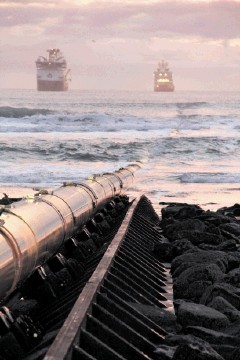
Sparsely populated and lying at the northernmost point of mainland Scotland, Caithness can feel like an island but it is not as remote and cut off as it might seem.
Just a 30-minute flight from Aberdeen, this quietly industrious corner of Scotland has just built the longest pipeline bundle in the world for the oil and gas industry at Subsea 7’s Wester site, near Wick.
The base is a valued employer in an area with higher-than-average unemployment, also supporting smaller businesses in the industry plus hotels, taxi firms, restaurants, Wick Airport and other local infrastructure.
It is a source of employment to 50-250 people any one time – some third-generation workers, with about 90% travelling in from local communities, including most of the management.
Fluctuations in staffing are soaked up by a versatile contractor workforce, according to Willie Watt, pipeline construction manager at the site.
Murray Lamont, who runs family-owned Mackay’s Hotel, at Wick, said the Wester site brought trade at lean times of the year.
He added: “It has also helped bring money and jobs to locals of a standard that they would probably have to go quite a distance to get otherwise.
“And it brings work for other engineering firms in the area, helps support pubs, restaurants, car-hire firms, the airport and general infrastructure.”
The industry out of Wester also supports Wick harbour, through the delivery of materials and larger components for the site and servicing tugs.
But with the winding down of the nuclear site at Dounreay, there is a concern in the area that more jobs will be needed.
It once employed thousands and still employs, directly and indirectly, an estimated 2,000 people, due to slump to about 100 in 10 to 15 years.
Lord Lieutenant of Caithness Anne Dunnett said in some ways the area had rested on its laurels because of employment at Dounreay, but that there was hope in renewables.
“With the closure of Dounreay there will be fewer jobs,” she said. “Renewables is a prospect for us and naturally we are well placed for wind and marine energy.”
Signs of the opportunities in renewables are already starting to show.
It is hoped the Pentland Firth leasing round will bring marine energy developments and jobs.
But it is offshore wind developments that are likely to be built sooner, according to Louise Smith, director of Thurso-based consultancy Caithness Renewables. She said: “Offshore wind will come first and will have a natural lead in to the marine industry.
“Servicing offshore wind will also be transferable into marine energy.
“It is small scale at the moment and a lot of it is speculative, but I know it is definitely going to be part of the economy so I thought I would set up my own business in it.
“I set up in August 2010 and there is a crazy amount of work out there.”
In fact, she is due to move into new offices at Easter and hopes to take on staff.
Others investing in renewables include the North Highland College at Thurso. Last year it opened a £9million engineering, technology and energy centre and a £3million marine research centre.
The harbour has already taken shipments of wind turbines and there will be more, with marine energy devices expected after that.
“They are looking at using Wick as an operations and maintenance base too,” said Wick harbourmaster Malcolm Bremner.
“The whole of Caithness will benefit.”
Until then – and beyond the predicted boom in renewables – Subsea 7’s Wester site will continue to play a key role supporting the local economy.
In fact, it could help unlock the renewables industry.
Mr Watt said: “You could say Subsea 7 is the anchor tenant.
“It’s the catalyst that keeps the investment coming and demonstrates to developers looking to marine and wind that we are successful here and that we are able to procure and deliver all the items needed to build a pipeline. And we too are interested in looking at renewables.”
Recommended for you
